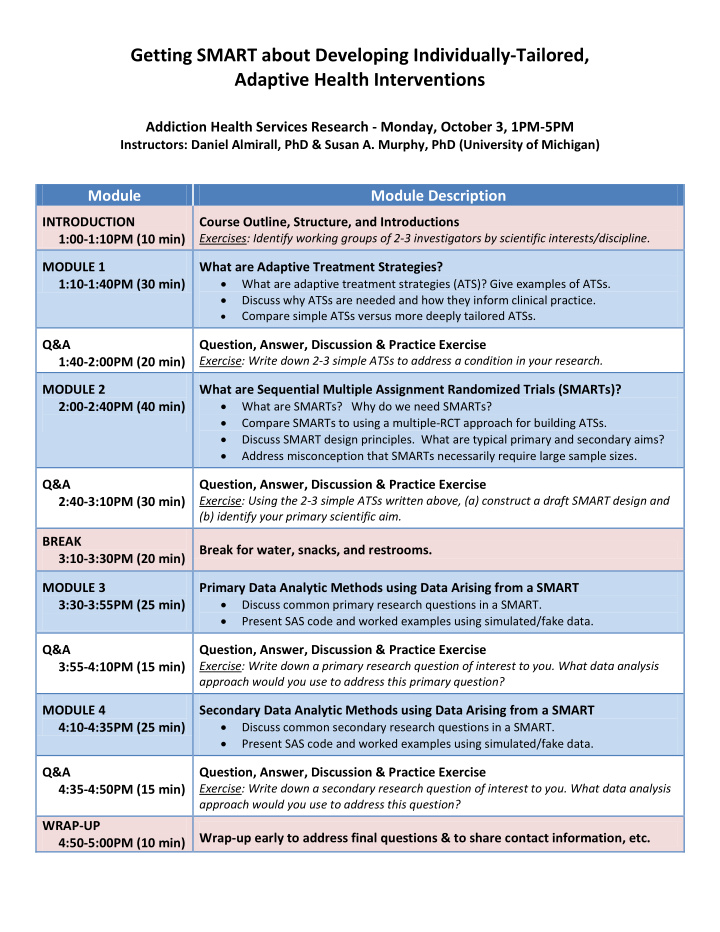



Getting SMART about Developing Individually-Tailored, Adaptive Health Interventions Addiction Health Services Research - Monday, October 3, 1PM-5PM Instructors: Daniel Almirall, PhD & Susan A. Murphy, PhD (University of Michigan) Module Module Description INTRODUCTION Course Outline, Structure, and Introductions Exercises: Identify working groups of 2-3 investigators by scientific interests/discipline. 1:00-1:10PM (10 min) MODULE 1 What are Adaptive Treatment Strategies? 1:10-1:40PM (30 min) What are adaptive treatment strategies (ATS)? Give examples of ATSs. Discuss why ATSs are needed and how they inform clinical practice. Compare simple ATSs versus more deeply tailored ATSs. Q&A Question, Answer, Discussion & Practice Exercise Exercise: Write down 2-3 simple ATSs to address a condition in your research. 1:40-2:00PM (20 min) MODULE 2 What are Sequential Multiple Assignment Randomized Trials (SMARTs)? 2:00-2:40PM (40 min) What are SMARTs? Why do we need SMARTs? Compare SMARTs to using a multiple-RCT approach for building ATSs. Discuss SMART design principles. What are typical primary and secondary aims? Address misconception that SMARTs necessarily require large sample sizes. Q&A Question, Answer, Discussion & Practice Exercise Exercise: Using the 2-3 simple ATSs written above, (a) construct a draft SMART design and 2:40-3:10PM (30 min) (b) identify your primary scientific aim. BREAK 3:10-3:30PM (20 min) Break for water, snacks, and restrooms. MODULE 3 Primary Data Analytic Methods using Data Arising from a SMART 3:30-3:55PM (25 min) Discuss common primary research questions in a SMART. Present SAS code and worked examples using simulated/fake data. Q&A Question, Answer, Discussion & Practice Exercise 3:55-4:10PM (15 min) Exercise: Write down a primary research question of interest to you. What data analysis approach would you use to address this primary question? MODULE 4 Secondary Data Analytic Methods using Data Arising from a SMART 4:10-4:35PM (25 min) Discuss common secondary research questions in a SMART. Present SAS code and worked examples using simulated/fake data. Q&A Question, Answer, Discussion & Practice Exercise 4:35-4:50PM (15 min) Exercise: Write down a secondary research question of interest to you. What data analysis approach would you use to address this question? WRAP-UP 4:50-5:00PM (10 min) Wrap-up early to address final questions & to share contact information, etc.
ADAPTIVE INTERVENTION Baseline Risk High Risk Low Risk Assessment BI-WEEKLY COURT AS-NEEDED COURT HEARINGS HEARINGS Monthly Progress Assessments NON-COMPLIANT RESPONSIVE & NON-RESPONSIVE COMPLIANT • ≥ 2 missed counseling sessions • ≥ 2 drug-positive urines and/or • ≥ 2 unexcused failures to provide a urine specimen If W a s As-Needed : If W a s Bi-Wee k l y: INTENSIVE CONTINUE AS BI-WEEKLY JEOPARDY CLINICAL CASE PREVIOUSLY COURT CONTRACT MANAGEMENT ASSIGNED HEARINGS
TCA + Typical Antipsychotic Stage 1 SSRI + Typical Antipsychotic Amoxapine Response TCA + Olanzapine/Risperidone Continuation SSRI + Olanzapine/Risperidone VLF + Typical Antipsychotic VLF + Olanzapine/Risperidone Partial Response or Nonresponse Efficacy Failure: Stage 2 (1) If Non-TCA, Go to TCA (2) If TCA, Go to Non-TCA Response or to Stage 3 Continuation Side Effect Failure: Different Drug Partial Response or Nonresponse Response Stage 3 ECT Continuation Partial Response or Nonresponse Previously Untried Stage 4 Response Stage 1 Agent + Lithium Continuation Augmenting Agent Partial Response or Nonresponse Other Stage 5 Response Agent Not Used in Continuation Stages 1 or 2 Go to Maintenance Phase When Indicated Figure 2. Strategies for the treatment of psychotic major depressive disorder. ECT indicates electroconvulsive therapy; SSRI, selective serotonin reuptake inhibitor; TCA, tricyclic antidepressant; VLF, venlafaxine. This figure is published with permission from the Texas Department of Mental Health and Mental Retardation and is part of a state-funded project.
ADHD in Children SMART Design Principal Investigator: W. Pelham Continue Responders Medication Medication Increase Medication Dose Non-Responders R Add Behavioral Intervention R Continue Responders Behavioral Intervention Behavioral Intervention Increase Behavioral Non-Responders R Intervention Add Medication O1 A1 O2 / R Status A2 Y
Recommend
More recommend